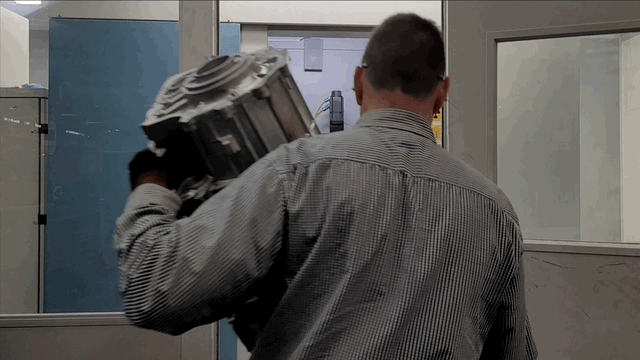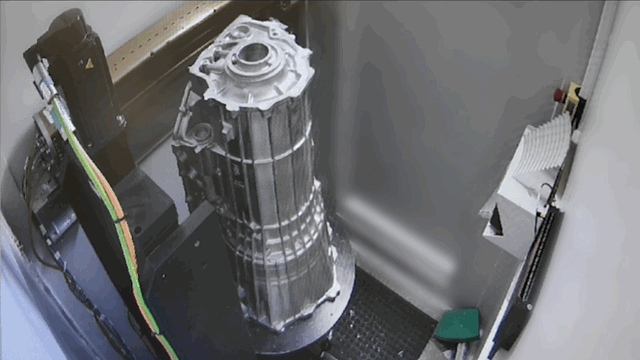By Sarah Foss, manager, manufacturing communications and Jenn McKeogh, senior manager, GM News

Doctors use CT scanning to look inside the human body, to diagnose fractures, tumors, heart disease, and other medical conditions. Surprisingly, the same technology – “computed tomography” – has applications in vehicle manufacturing. The team at General Motors’ Bedford Casting Plant in Indiana has been using CT to detect defects in our castings since 2019.
Quality castings
GM uses both sand and die casting technology to make a wide variety of automotive parts. The team at Bedford uses high pressure die casting (HPDC), a process where liquid metal is rapidly poured and injected into dies made of steel to create a metal part. The metal cavity fills in milliseconds with a total cycle time of about 60 to 90 seconds for most parts. The casting is removed from the die and machined to its final specifications to ensure the part meets specified dimensions.
Bedford pours over a half million pounds of molten aluminum each day to make cylinder blocks, transmission cases, structural components, and EV drive unit housings for Chevrolet, Cadillac, GMC, and Buick vehicles. Prior to shipping these castings to other GM facilities to create complete propulsion components, GM uses CT scanning and digital machining to help ensure quality and consistency.
Corey Beechboard is a senior process engineer and the “data doctor” behind Bedford’s CT scanning. His team discovered that utilizing a CT scanner along with digital machining could greatly reduce instances of defects and increase part quality.

Beechboard loads a 10-speed transmission casing into the CT scanner at the Bedford Casting plant.
“Using this technology allows us to react faster and make smarter choices,” Beechboard says. “Another benefit is we aren’t wasting castings so we can elevate our confidence level in the parts we produce.”
Beechboard came to GM in 2024 with nearly 26 years of experience in process engineering and technology. As the “data doctor,” he now leads the charge in implementing CT scanning and digital machining at Bedford, leaning on his expertise to further improve quality in our cast parts.
“With my experience in analyzing data, I’m confident that when I find a defect, it will actually be there and ensure results are accurate,” Beechboard says.
How it works
The castings are run through a CT scanner, which generates 3D images that are then used to create digital images for analysis – all without causing damage to the castings. Similar to a medical CT scan, this technology provides a multi-layer look inside a component, as opposed to an X-Ray, which only sees a single layer
“It sounds odd, but humans are less ‘dense’ than the metal parts we scan at GM,” says Alan Weaver, GM engineering group manager of measurement systems. “The scanners we use are even more powerful and detailed.”
These scans work to identify potential defects, like porosity in the form of small air bubbles or shrink holes in the casting. These could cause the part to be lower in density or have gaps.

A 10-speed transmission casing rotates inside the CT scanner, evaluating the part three-dimensionally.
Proven results
With this technology, the Bedford team continues to see improvements in casting quality and manufacturing speed. This innovative approach not only showcases our commitment to quality and craftsmanship for our customers, but also positions GM as a leader in manufacturing and technology.
Benefits for our customers
- CT scanning can detect porosity and prevent air bubbles or pockets in castings that makes the metal less sound.
- Higher quality parts can mean less potential warranty concerns and less repair costs coming out of the customer’s pocket related to these parts.
Benefits for the Business
- This technology allows GM to make faster, smarter manufacturing decisions, improve product quality, and reduce waste. CT scanning allows Bedford to perform quality checks 50 to 70 percent faster.
- The Bedford team serves as a benchmark to support other GM facilities in using this technology, helping to enhance quality across our operations. This includes providing an in-depth analysis or quality evaluation of castings or components.

The Bedford team is currently operating their CT Scanner up to 18 hours per day scanning parts for themselves and other casting facilities at GM, with future manufacturing applications planned in both our foundry and components plants.
GM is also using CT scanning technology in other areas of the business – like EV battery diagnostics at our battery labs across the GM Global Tech Center in Warren, Michigan, and fuel cell scanning at the Pontiac Engineering Center. And expansion of this tech is currently planned in the coming months.
“Right now, we’re making the highest quality castings we’ve ever produced,” says Carl Holmberg, engineering manager at Bedford. “We’ve had other sites send us components and say, ‘hey, can you guys scan this for us?’ So now we’re trying to help the rest of the company with this new technology.”
Learn more about how GM is innovating across manufacturing, engineering and more: